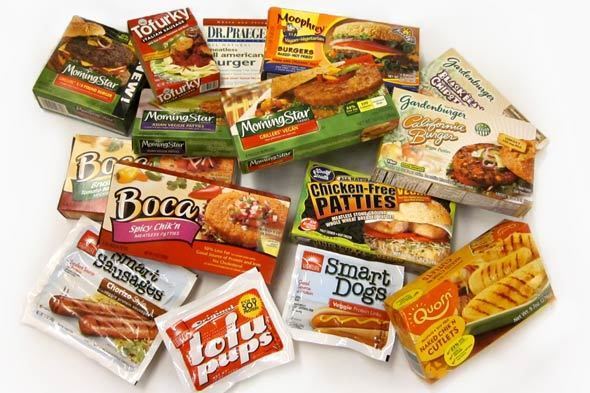 | ||
Similar Tofu, Wheat gluten, Quorn, Tempeh, Veggie burger | ||
A meat analogue, also called a meat alternative, meat substitute, mock meat, faux meat, imitation meat, or (where applicable) vegetarian meat or vegan meat, approximates certain aesthetic qualities (primarily texture, flavor and appearance) and/or chemical characteristics of specific types of meat. Many analogues are soy-based (see: tofu, tempeh) or gluten-based.
Contents
- History
- Animal protein analogues
- Composition
- Processing
- Physical structure
- Surimi and similar meat based meat analogues
- References
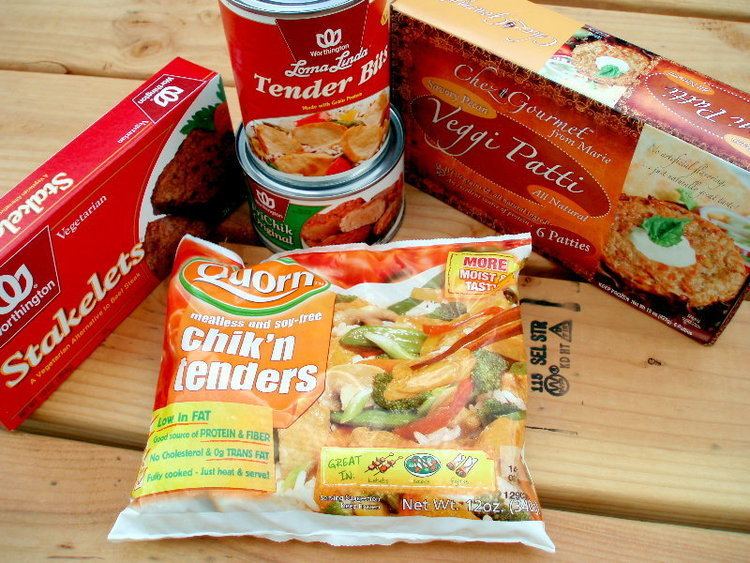
Generally, meat analogue is understood to mean a food made from non-meats, sometimes without other animal products, such as dairy. The market for meat imitations includes vegetarians, vegans, non-vegetarians seeking to reduce their meat consumption for health or ethical reasons, and people following religious dietary laws in Hinduism, Judaism, Islam, and Buddhism.
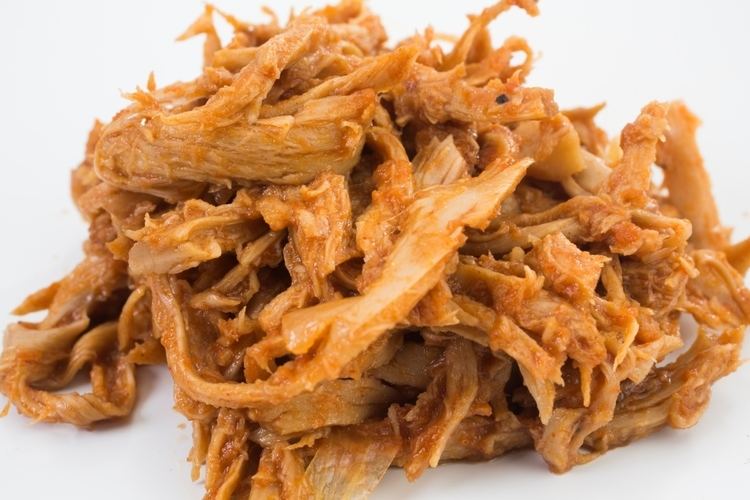
Tofu, a popular meat analogue, was invented in the Han dynasty. A document written by Tao Gu (903–970) describes how tofu was called "small mutton" and valued as an imitation meat. Meat analogues such as tofu and wheat gluten are associated with Buddhist cuisine in China and other parts of East Asia. In Medieval Europe, meat analogues were popular during Lent, when the consumption of meat from warm-blooded animals is forbidden.
Meat analogue may also refer to a meat-based and/or less-expensive alternative to a particular meat product, such as surimi.
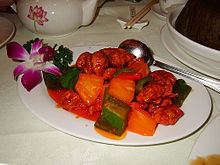
Another alternative meat technology is cultured meat from in vitro-grown muscle tissue.
History
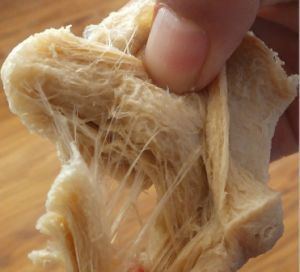
Tofu, a popular meat analogue, was invented in China by the Han dynasty (206 BC–220 AD). Drawings of tofu production have been discovered in a Han dynasty tomb. Its use as a meat analogue is recorded in a document written by Tao Gu (903–970). Tao describes how tofu was popularly known as "small mutton" (xiao zaiyang), which shows that the Chinese valued tofu as an imitation meat. Tofu was widely consumed during the Tang dynasty (618–907), and likely spread to Japan during the later Tang or early Song dynasty.
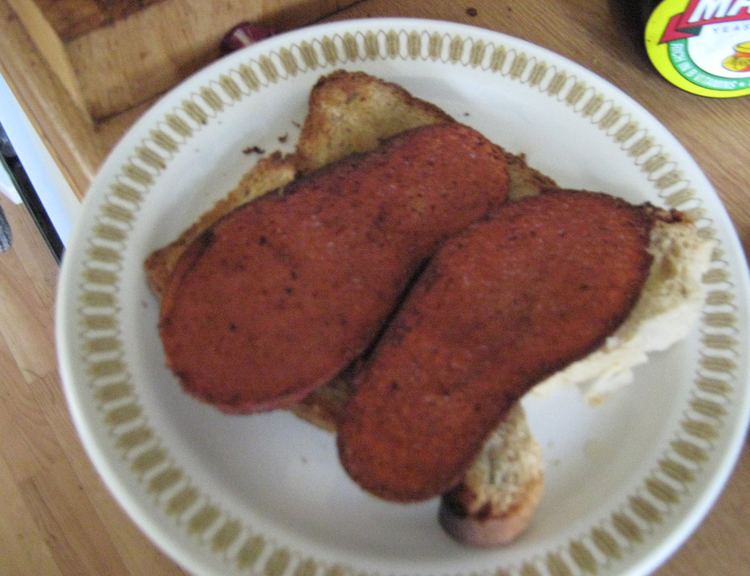
Prior to the arrival of Buddhism, China was predominantly a meat consuming culture. The vegetarian dietary laws of Buddhism led to development of meat analogues as a replacement for the meat-based dishes that the Chinese were no longer able to consume as Buddhists. Meat analogues such as tofu and wheat gluten are still associated with Buddhist cuisine in China and other parts of East Asia. Meat analogues were also popular in Medieval Europe during Lent, which prohibited the consumption of warm-blooded animals, eggs, and dairy products. Chopped almonds and grapes were used as a substitute for mincemeat. Diced bread was made into imitation cracklings and greaves.
Animal protein analogues
Some vegetarian meat analogues are based on centuries-old recipes for seitan (wheat gluten), rice, mushrooms, legumes, tempeh, yam flour or pressed-tofu, with flavoring added to make the finished product taste like chicken, beef, lamb, ham, sausage, seafood, etc. Yuba and textured vegetable protein (TVP) are other soy-based meat analogues. The first is made by layering the thin skin which forms on top of boiled soy milk. the second is a dry bulk commodity derived from soy and soy protein concentrate.
Some meat analogues include mycoprotein-based Quorn (which usually uses egg white as a binder; only Vegan Burger is suitable for vegans), and modified defatted peanut flour and Valess (which is a sort of cheese, made from cow milk and seaweed).
Dairy analogues may be composed of processed rice, soy (tofu, soymilk, soy protein isolate), almond, cashew, gluten (such as with the first non-dairy creamers), nutritional yeast, or a combination of these, as well as flavoring to make it taste like milk, cheeses, yogurt, mayonnaise, ice cream, cream cheese, sour cream, whipped cream, buttermilk, rarebit or butter. Many dairy analogues contain casein, which is extracted dried milk proteins, making them unsuitable for vegans.
Egg substitutes include tofu, tapioca starch, ground flax seed, aquafaba, mashed bananas, applesauce and commercially prepared products that recreate the leavening, binding and/or textural effects of eggs in baked goods.
In 2016 Impossible Foods began delivering its beef substitute, which it claimed offered appearance, taste and cooking properties very similar to meat. It uses a synthetic heme compound that is produced by genetically modified yeasts. Heme is the molecule that carries oxygen in human blood. The company has raised $182 million in funding. To replicate fat, flecks of coconut oil are mixed into ground textured wheat and potato protein.
Composition
Soy protein isolates or soybean flour and gluten are usually used as foundation for most meat analogs that are available on the market. Soy protein isolate is a highly pure form of soy protein with a minimum protein content of 90%. The process of extracting the protein from the soybeans starts with the dehulling, or decortication, of the seeds. The seeds are then treated with solvents such as hexane in order extract the oil from them. The oil-free soybean meal is then suspended in water and treated with alkali to dissolve the protein while leaving behind the carbohydrates. The alkaline solution is then treated with acidic substances in order to precipitate the protein, before being washed and dried. The removal of fats and carbohydrates, results in a product that has a relatively neutral flavor. Soy protein is also considered a “complete protein” as it contains all of the essential amino acids that are crucial for proper human growth and development.
Lipids are added to the meat analog in the form of liquid or semi-liquid glyceride shortening from synthesis, or other sources such as plants or animals. The glycerides could potentially contain unsaturated or saturated long chain acyl radicals ranging from 12 to around 22 carbon atoms. Due to the target audience of meat analogs, plant based lipid sources such as soybean oil, olive oil, canola oil, and others alike are usually used. While lipids do not contribute to the structure of the meat analog, it is crucial in increasing the palatability and broadening the appeal of the product across the consumer base.
Food additives include flavor compounds, coloring agents, leavening agents, and emulsifiers. Sodium bicarbonate is a commonly used leavening agent in a variety of baked products such as bread and pancakes. The carbon dioxide released by sodium bicarbonate aids in the expansion and the unilateral stretching of the protein network during production. A variety of emulsifiers can be to stabilize the meat analog system. These could include, but are not limited to polyglycerol monoesters of fatty acids, monoacylglycerol esters of dicarboxylic acids, sucrose monoesters of fatty acids, and phospholipids. Polyglycerol monoesters consist on average of 2 to 10 glycerol units and an average of one acyl fatty acid group per glycerol component. The polymer is created from esterification reactions with fatty acids and contains 14 to 16 carbons per polyglycerol moiety. Sucrose monoesters are derived from the esterification of sucrose with a fatty acid ester or a fatty acid and it ideally should have a fatty acyl group ranging from 14 to 18 carbon atoms. Lastly, phospholipid such as lecithin, cephalin, and sphingomyelin can also be used as effective emulsifiers. In addition, some of the emulsifier act as a lubricant during the extrusion process.
Overall the composition of dry protein mix can contain between 30% to 100% water-hydratable, heat-coagulable protein by weight. A dry mix that contains 100% protein content yields the most desirable fibrous texture, but from the palatability standpoint between 50% to 70% was determined to generate the most positive feedback. Protein content of lower than 30% would inhibit the formation of meat-like fibers during processing. The optimal fat content for the desirable mouth feel was determined to be around 30% to 40% by weight.
Processing
Meat analog products are currently made by two basic processes, through either thermoplastic extrusion or fiber spinning. Thermoplastic extrusion involves the adaptation of production processes that are more commonly associated with the making of ready-to-eat cereal products. Extruders are simple in nature and are considered to be a cost effective method of accommodating large scale productions. It also provides the conditions that are crucial to the formation of the desirable fibers. The wet mix is mixed in a heated vessel at a temperature lower than the coagulation temperature of the proteins. The elevated temperature assists in lowering the viscosity of the dough and allows for a more homogenized mixing process. Special caution must be taken as to not over mix the dough as it has been known to substantially decrease the amount of fibers formed.
Extruders should be set to the temperature in which the protein used will start to coagulate for max efficiency. Gluten and soy proteins coagulate at 75 °C and 68 °C respectively. Due to the fact that the extruder also cooks the product, the temperature of the inner walls of extruder should be within the range of 77 °C to 149 °C. Turbulent conditions caused by aggressive mixing and agitation should be avoided during processing as it contributes to the undesirable formation of randomly oriented, non-meat like fibers. Unidirectional and parallel fibers can only be formed through extruding and stretching under none turbulent, or laminar, conditions. Laminar flow condition occurs under low velocities where the fluid in question flows smoothly with overlapping layers, and it is characterized by having a Reynold number of less than 2040. Stretching of the meat analog would take place simultaneously during the extrusion. Ideally, the amount of linear expansion of the protein dough should be around 50% in either direction.
Fiber spinning method is not commonly used to produce meat analogs due to its complexity, and it also negates one of the key advantages of meat analogs. This method of production increases the cost of production, which eliminates the advantage of creating an inexpensive meat/protein substitute. The fiber spinning techniques were adopted from the spun fiber method used to create synthetic fibers in the textile industry. In general, fibers are made through creating filaments out of the protein used as the starting material. The process begins through the dispersion of proteins into a dispersing medium such as an alkaline aqueous solution. This dispersion is then fed through a spinneret, a device used to extrude a polymer solution to form fibers, and deposited into an acidic salt solution with a pH range of 5.6 to 6.4 for coagulation. The filaments after exiting the small die of the spinneret would have a diameter of around .003 inches. These filaments are then stretched and elongated until the average thickness is around 20 microns.
Excess salt solution is then removed from the fibers through squeezing or centrifuging prior to further processing. After the drying process, edible binders such as proteins, starches, cereals, dextrins, carboxy methyl cellulose, or a combination of them, are added to keep the fibers physically tied together through functioning as an adhesive or serving as a matrix in which the fibers embed upon. The fibers are then passed through a bath of melted fat and proceed to be pressed together to form the final product. The meat analog is then cut into suitable length for either packaging and distribution or further processing. Overall this method allows for the desirable formation of highly fine fibers, but at the cost of longer and more complicated processing steps, as well as incurring an increase in cost. Regardless of which method was used, the final product should be stored under at temperatures ranging from 13 °C to 21 °C. Ideally the humidity should be around 15%. The expected shelf life of meat analog products while in an air tight package is up to 10 years, while it its only up to 1 year when it has been opened.
Physical structure
The formation of fibers through protein coagulation can be described through the wool and fiber models. “Silk” fibers are characterized by its relatively high content of alanine, glycine, and serine; these make up over 80% of the protein residue. In order to give sufficient cohesion to resist flow, these protein chains form a tight fit over a large area. The proximity of the chains allows for firm hydrogen bonding to occur along the peptide bonds of the chain backbone. Although hydrogen bonds are relatively weak non-covalent interaction, the sheer quantity of them increases their overall effectiveness in maintaining the structure.
The “wool” model is the more important model of the two as the composition of natural protein resembles wool rather than silk. This type of fiber is stabilized through cross-linkages as it provides strength and prevents plastic flow resulting from slippage of protein chains. Wool is much less crystalline due to its greater bulkiness of its side chains. About 50% of the weight is composed of side chains. Due to the abundance of hydrophobic groups, wet wool fibers are considerably stronger than other synthetically made protein fibers. This is the result of stabilizing through disulfide linkages. When these bonds are broken at elevated temperature through hydrolysis or reduction, the wet wool fibers lose its unique strength and act like typical synthetic protein fibers.
The folding and the unfolding of the proteins also contribute to the physical and mechanical properties of the fibers formed. Studies have shown that reversible “sol-gel” transformations within the amorphous areas of the fibers. Sol-gel refers to the production of solid materials from small molecules. In material science, the process involves the transformation of monomers into a colloidal solution (sol) that acts as the precursor to an integrated matrix (gel). When the stabilizing bond between the fibers are broken, the system responds by unfolding or slipping in attempt to relieve the tension. The bonds would then rearrange in a less stressed position. The uncoiling of the fibers, and to a less extent the stretching of bonds, contributes to the elastic properties of the fiber. While the plastic properties, or flow, are due to the slipping of protein chains pass one another.
The behavior of the fibers can be shown by mechanical models consisting of combinations of springs and dashpots connected in various combinations as demonstrated in figure 2. The deformation of fibers can either be reversible, in the form of elastic properties, or irreversible, in the form of plastic properties. The elastic properties are represented by Hooke’s law constant (g1 and g2), while the plastic properties are presented by a dashpot characterized by viscosity (μ). The system in which the spring is in conjunction with the dashpot on the right side of figure is known as the Maxwell viscoelastic unit. The deformation can then be described by the spring system in conjunction with the Maxwell unit. An applied force, f1, on this model would be the sum of the partial forces f1 on the spring at the left and f2 on the Maxwell unit. The resulting strain on the system is dependent on the spring constants and the viscosity of the dashpot. The general assumption is that the dashpot behavior is Newtonian, in which the flow of the viscous elements is directly proportional to the applied stress on the element. This model only provides a simplified behavior of fibers, but in most cases, especially the protein fibers, the characteristics are much more complex.
The matrix formed by the protein network is also affected by temperature. Temperature has a large impact on the elastic properties of the fibers. The interaction is similar to the influence of temperature on a gas. The elastic tension of the stretched fibers is dependent upon the entropy of the system in a manner analogous to the pressure of a confined gas. When the temperature of the fiber is increased the thermal motion, like the pressure of a heated gas is increased. Equilibrium force acting on the rubber-like fiber is determined by thermal kinetic motions of free chain segments between network junctions. The thermal motions of the free chain segments promote random coiling at the junctions, thus maximizing entropy. A larger force is then required to displace the chains from the position similar to the pressure required to compress a gas. The elasticity of the fiber is increased as a direct result.
The emulsion in this instance is a water-in-oil one. Studies have shown that by surrounding the water soluble flavor extracts with the continuous oil phase of the emulsion resulted in a slower rate of flavor dispersion from the water, leading to the prolonged taste of flavor in the final product. The oil phase effectively prevents the flavor-containing water particles from leaching out from the product and transferring to the surrounding environment, such as sauces or other food materials.
Surimi and similar meat-based meat analogues
Surimi, a processed hash of fish plus flavorings, is used to make products such as imitation crab meat. In some regions, "surimi" refers only to products made from fish.
Examples of surimi include:
Surimi products are often marketed as "imitation" meats (e.g., "imitation crab meat", "imitation shrimp").
